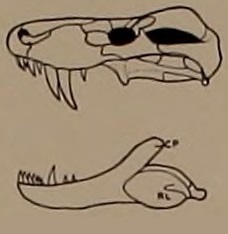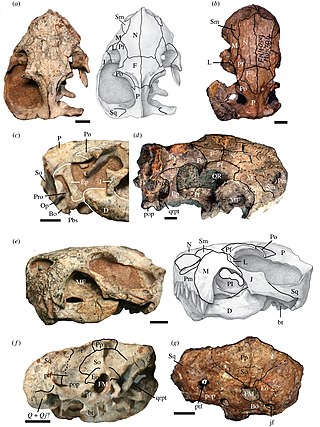
Gorgonopsia is an extinct clade of sabre-toothed therapsids from the Middle to the Upper Permian, possibly even up to the Early Triassic, roughly between 265 and 252 million years ago. They are characterised by a long and narrow skull, as well as elongated upper and sometimes lower canine teeth and incisors which were likely used as slashing and stabbing weapons. Postcanine teeth are generally reduced or absent. For hunting large prey, they possibly used a bite-and-retreat tactic, ambushing and taking a debilitating bite out of the target, and following it at a safe distance before its injuries exhausted it, whereupon the gorgonopsian would grapple the animal and deliver a killing bite. They would have had an exorbitant gape, possibly in excess of 90°, without having to unhinge the jaw.

Therocephalia is an extinct clade of eutheriodont therapsids from the Permian and Triassic periods. The therocephalians ("beast-heads") are named after their large skulls, which, along with the structure of their teeth, suggest that they were carnivores. Like other non-mammalian synapsids, therocephalians were once described as "mammal-like reptiles". Therocephalia is the group most closely related to the cynodonts, which gave rise to the mammals, and this relationship takes evidence in a variety of skeletal features. Indeed, it had been proposed that cynodonts may have evolved from therocephalians and so that therocephalians as recognised are paraphyletic in relation to cynodonts.

Trochosaurus is a dubious genus of therocephalian therapsid from South Africa based upon specimens of Lycosuchidae. Three species of Trochosaurus have appeared in literature, T. intermedius, T. major, and T. dirus. The genus Trochosaurus and all three species are considered nomen dubia today, while the specimens referred to them are regarded as Lycosuchidae incertae sedis.

Euchambersia is an extinct genus of therocephalian therapsids that lived during the Late Permian in what is now South Africa and China. The genus contains two species. The type species E. mirabilis was named by paleontologist Robert Broom in 1931 from a skull missing the lower jaw. A second skull, belonging to a probably immature individual, was later described. In 2022, a second species, E. liuyudongi, was named by Jun Liu and Fernando Abdala from a well-preserved skull. It is a member of the family Akidnognathidae, which historically has also been referred by as the synonymous Euchambersiidae.

Bauria is an extinct genus of the suborder Therocephalia that existed during the Early and Middle Triassic period, around 246-251 million years ago. It belonged to the family Bauriidae. Bauria was probably a herbivore or omnivore. It lived in South Africa, specifically in the Burgersdorp Formation in South Africa.

Moschorhinus is an extinct genus of therocephalian synapsid in the family Akidnognathidae with only one species: M. kitchingi, which has been found in the Late Permian to Early Triassic of the South African Karoo Supergroup. It was a large carnivorous therapsid, reaching 1.5 m (4.9 ft) in total body length with the largest skull comparable to that of a lion in size, and had a broad, blunt snout which bore long, straight canines.

Pristerognathus is an extinct genus of therocephalian, known from the late Middle Permian (Capitanian) of South Africa. It lends its name to the Pristerognathus Assemblage Zone of the Beaufort Group of South African geological strata. Pristerognathus was a medium-sized therocephalian with a 25 cm (9.8 in) skull and a total length up to 1.5 m.

Lycosuchus is an extinct genus of carnivorous therocephalians which lived in the Middle Permian 265—260 Ma existing for approximately 5 million years. As a member of the Lycosuchidae, the genus represents one of the earliest diverging therocephalians. The type and only species, L. vanderrieti, is known from a handful of well-preserved specimens featuring the cranium and lower jaw; the holotype US D173 housed at the University of Stellenbosch, South Africa, is a near complete occluded skull. Specimen MB.R. 995, housed at the Museum für Naturkunde Berlin, Germany, consists of a near complete and isolated lower jaw, along with a partial snout and brain case. With the help of μCT data, Pusch et al (2020) described the endocranial anatomy of Lycosuchus vanderrieti.

Theriognathus is an extinct genus of therocephalian therapsid belonging to the family Whaitsiidae, known from fossils from South Africa, Zambia, and Tanzania. Theriognathus has been dated as existing during the Late Permian. Although Theriognathus means mammal jaw, the lower jaw is actually made up of several bones as seen in modern reptiles, in contrast to mammals. Theriognathus displayed many different reptilian and mammalian characteristics. For example, Theriognathus had canine teeth like mammals, and a secondary palate, multiple bones in the mandible, and a typical reptilian jaw joint, all characteristics of reptiles. It is speculated that Theriognathus was either carnivorous or omnivorous based on its teeth, and was suited to hunting small prey in undergrowth. This synapsid adopted a sleek profile of a mammalian predator, with a narrow snout and around 1 meter long. Theriognathus is represented by 56 specimens in the fossil record.
Cerdodontenuidens is an extinct genus of gorgonopsian therapsids. However, some consider this genus to be a nomen dubium. The holotype skull is of a crushed skull of a small therocephalian.

Eriphostoma is an extinct genus of gorgonopsian therapsids known from the Middle Permian of Tapinocephalus Assemblage Zone, South Africa. It has one known species, Eriphostoma microdon, and was first named by Robert Broom in 1911. It is the oldest known gorgonopsian and among the smallest and most basal members of the clade.

Glanosuchus is a genus of scylacosaurid therocephalian from the Late Permian of South Africa. The type species G. macrops was named by Robert Broom in 1904. Glanosuchus had a middle ear structure that was intermediate between that of early therapsids and mammals. Ridges in the nasal cavity of Glanosuchus suggest it had an at least partially endothermic metabolism similar to modern mammals.

Scymnosaurus is a dubious genus of therocephalian therapsids based upon various fossils of large early therocephalians. The genus was described by Robert Broom in 1903 with S. ferox, followed by S. watsoni in 1915 and a third, S. major, by Lieuwe Dirk Boonstra in 1954. Each of these species are considered nomen dubia today and based upon specimens belonging to two separate families of therocephalians. S. ferox and S. major represent specimens of Lycosuchidae incertae sedis, while S. watsoni is Scylacosauridae incertae sedis. Broom named a fourth species in 1907 from KwaZulu-Natal, S. warreni, though he later referred it to Moschorhinus as a valid species in 1932 but now is recognised as being synonymous with M. kitchingi.

Lycosuchidae is an extinct family of therocephalian therapsids from the Middle Permian Beaufort Group of South Africa. It currently contains two monotypic genera, Lycosuchus, represented by L. vanderrieti, which was named by paleontologist Robert Broom in 1903, and Simorhinella, represented by S. baini, which was named by Broom in 1915. Both species are characterized by their large body sizes and short, deep snouts. Two sets of enlarged canine teeth were once regarded as a defining feature of lycosuchids, but recent studies have proposed that the front-most pair are replacements for the ones behind them, which would have eventually fallen out as individuals aged. Lycosuchids are the earliest known therocephalians and are also thought to be the most basal.

Scylacosauridae is an extinct family of therocephalian therapsids. Scylacosaurids lived during the Permian period and were among the most basal therocephalians. The family was named by South African paleontologist Robert Broom in 1903. Scylacosaurids have long snouts and unusual saber-like canine teeth.

Bauriidae is an extinct family of therocephalian therapsids. Bauriids were the latest-surviving group of therocephalians after the Permian–Triassic extinction event, going extinct in the Middle Triassic. They are among the most advanced eutherocephalians and possess several mammal-like features such as a secondary palate and wide postcanine teeth at the back of the jaws. Unlike other therocephalians, bauriids were herbivorous. They were also smaller than earlier members of the group. Two subfamilies are classified within Bauriidae: Nothogomphodontinae and Bauriinae.

Blattoidealestes is an extinct genus of therocephalian therapsid from the Middle Permian of South Africa. The type species Blattoidealestes gracilis was named by South African paleontologist Lieuwe Dirk Boonstra from the Tapinocephalus Assemblage Zone in 1954. Dating back to the Middle Permian, Blattoidealestes is one of the oldest therocephalians. It is similar in appearance to the small therocephalian Perplexisaurus from Russia, and may be closely related.
Silpholestes is an extinct genus of therocephalian therapsids from the Late Permian of South Africa. The type species Silpholestes jackae was named by South African paleontologist Robert Broom in 1948 from the Cistecephalus Assemblage Zone.
Simorhinella is an extinct genus of therocephalian therapsids from the Late Permian of South Africa. It is known from a single species, Simorhinella baini, named by South African paleontologist Robert Broom in 1915. Broom named it on the basis of a single fossil collected by the British Museum of Natural History in 1878 that included the skull and jaws forward from the eye sockets. The skull is unusual in that it has an extremely short and deep snout, unlike the longer and lower snouts of most other therocephalians. Because of the skull's distinctiveness, the classification of Simorhinella within Therocephalia is uncertain. However, a 2014 study proposed that it was closely related to the basal therocephalian Lycosuchus, placing it in the family Lycosuchidae.

Ictidosaurus was a therapsid genus found in the Abrahamskraal Formation of South Africa, which lived during the middle Permian period. Fossils of the type species were found in the Tapinocephalus, and the base of the Eodicynodon assembly zones, of the Karoo Basin. Older classifications of the species, along with many other specimens found in the Iziko South African Museum archives, were originally classified within therocephalian family names, in this case the Ictidosauridae, which has been reclassified as belonging to the Scylacosauridae. The type species is I. angusticeps.




















